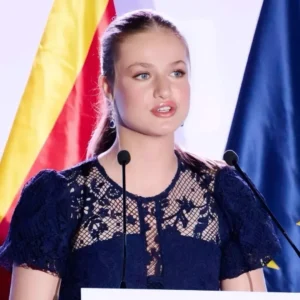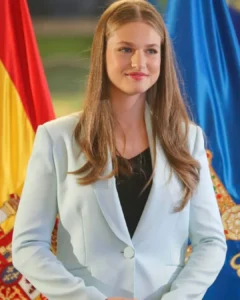Princess Leonor of Spain: The Future Queen’s Journey of Duty, Honor, and Leadership
From the moment she was born in Madrid on October 31, 2005, Leonor de Borbón y Ortiz has lived under the weight of high expectations and profound opportunity. As the eldest daughter of King Felipe VI and Queen Letizia, her life has been shaped by tradition, education, duty, and the evolving role of monarchy in modern Spain. Here’s an in-depth look into the life of the future Queen of Spain.

👶 Early Life and Background
Born via caesarean at Madrid’s Ruber International Hospital, Leonor was three weeks premature. Announced to the world via SMS, she entered the world with great fanfare (more.io.vn). Baptized two months later in the Royal Palace of Zarzuela, her godparents were none other than her grandparents, former King Juan Carlos I and Queen Sofía (more.io.vn).
Her full name—Leonor de Todos los Santos de Borbón y Ortiz—echoes royal custom. She earned her first formal titles in 2014, when her father ascended to the throne: Princess of Asturias (the principal heir’s title), alongside Princess of Girona, Princess of Viana, Duchess of Montblanc, Countess of Cervera, and Lady of Balaguer (casareal.es).
🎓 Education: Grounding Nobility in Reality
Leonor’s schooling began in earnest at Escuela Infantil Guardia Real, the Royal Guard’s preschool, and from 2008 attended Santa María de los Rosales in Aravaca, the same primary school her father went to (more.io.vn). Reports describe her as a diligent, well-rounded student, consistently noted for strong academic performance (it.wikipedia.org).
Early on, she displayed remarkable linguistic skills. Fluent in Spanish, Catalan, and English, she also studied French, Galician, Basque, Arabic, and Mandarin—evidence of her family’s broad vision for her future role (more.io.vn).
📚 International Baccalaureate & Global Exposure
In September 2021, she enrolled at the prestigious United World College Atlantic College in Wales for the IB program. Living in dorms, Leonor was described as humble and intellectually curious—it was here she began to earn admiration on the international stage (hellomagazine.com).
Graduating in May 2023, she received high marks, affirming her place as a student of substance, not just stature .

🎖️ Military Training: Following in Royal Footsteps
In August 2023, Leonor embarked on a three-year military training plan, officially following Spain’s tradition of heirs serving in the armed forces (en.wikipedia.org). Training covers the Army (Zaragoza), Navy (Marín), and Air Force (Murcia):
- Army (Year 1): She began at the General Military Academy in Zaragoza on August 17, 2023. By September 19, she received her officer’s sabre, and on October 7 pledged loyalty to the flag. She participated in traditions like the Pascua Militar and engaged in physical challenges, even winning silver in fencing at the Military Academy Sports Championship in January 2024 (en.wikipedia.org).
- Naval service (2024–25): Elevated to cadet ensign and awarded the Grand Cross of Military Merit in early July 2024, she joined the Naval Academy in Marín on August 29. Over the next months, she trained in seamanship and embarked on the legendary Juan Sebastián de Elcano in January 2025—a rigorous five-month voyage representing tradition and endurance (en.wikipedia.org).
- Upcoming Air Force (2025–26): She will complete her training at the General Air Academy in Murcia, rounding out the triumvirate of military command—Army, Navy, Air Force—preparing her to one day be Commander-in-Chief (1tak.com).
🏛️ Royal Duties & Official Roles
Becoming Heir Apparent
Though legally heir since her birth, Leonor’s official coming-out as Princess of Asturias cannot occur until her 18th birthday. On October 31, 2023, she took the constitutional oath before Parliament, pledging loyalty to the Constitution, laws, citizens, autonomous regions—and most poignantly, to the king himself (townandcountrymag.com).
The event was symbolic: She received the Collar of the Order of Charles III and walked solemnly in a white pantsuit that drew comparisons to Kate Middleton’s sartorial elegance (townandcountrymag.com).
Royal Appearances & Public Engagements
Leonor began appearing at high-profile events in her teens:
- At age 9, she accompanied her family during Easter Mass and visited airbases.
- At 13, she gave her first speech reading Article 1 of the Constitution (hellomagazine.com, deultimominuto.net).
- In 2019 and 2021, she spoke at the Princess of Asturias Awards and Instituto Cervantes events, earning praise for her poise and eloquence (deultimominuto.net).
- In July 2024, she made her first official international visit to Portugal, championing environmental causes (hellomagazine.com).
Her growing confidence on both domestic and international stages has strengthened a public mood dubbed “Leonormania,” particularly among Spanish women who see her as a role model (thetimes.co.uk).

🏅 Honours, Titles, and Impact
Leonor’s growing list of distinctions underscores her evolving role:
- 2015: Appointed Dame of the Order of the Golden Fleece.
- October 2023: Excelled the Collar of the Order of Charles III; received Gold Medals from the Senate, Congress, Community of Madrid; Honorary Mayor of Oviedo.
- July 2024: Awarded Grand Cross of Military Merit (White Decoration); promoted to Cadet Ensign.
- July 2024: Named Midshipman and entered the Naval Academy.
- Additional regional honors include medals from Aragón, Galicia and being an Adoptive Daughter of Zaragoza (thecityceleb.com, en.wikipedia.org, deultimominuto.net).
🧩 Personal Traits, Interests & Public Persona
Though her lifestyle carries royal privilege, Leonor projects simplicity and focus. Observers note her humility, intellectual curiosity, and dedication—traits uncommon in traditional royalty yet essential today .
Also athletic and musically inclined, she enjoys tennis, basketball, skiing, cello, and sailing (systummhaibhai.com).
Her private moments, like her shy smile when diverted by a military cadet’s greeting, reveal warmth and relatability .
🌍 Navigating a Modern Monarchy
Leonor emerges in a complex era. Spain’s monarchy has weathered scandals—from King Juan Carlos’s financial controversies to broader institutional scrutiny (vogue.com). King Felipe VI and Queen Letizia have worked to restore integrity and public trust. Leonor’s promise sits at the center of this aspiration.
She represents continuity and renewal: the first queen regnant since Isabella II (19th century) and the first modern-era Spanish heir fully prepared for constitutional duty (apnews.com, systummhaibhai.com).
Polls suggest optimism: about two-thirds of Spaniards believe she will succeed where others struggled—a sign that “Leonormania” may reflect genuine hope (vanityfair.com).

🔮 What Lies Ahead?
- Complete military training in late 2025.
- Possible university studies, perhaps international relations or public policy—an educated global monarch in the making.
- Gradual assumption of more official duties domestically and abroad.
By combining traditional service (military, monarchy) with modern education, empathy, and reform-minded engagement, Leonor could define a new generation of royalty—one that speaks to contemporary values while respecting centuries-old ceremonies.
✍️ Final Word
At just 19, Princess Leonor stands at the intersection of duty and transformation. With fluency in multiple languages, a grounding in democracy, a foundation in international education, and meaningful military credibility, she seems prepared for the immense responsibilities ahead.
But beyond titles and training, her true value lies in her authenticity—Leonor shows empathy, humility, and dedication. Whether walking into a military parade, greeting citizens in Oviedo, or standing before Parliament, she carries the quiet confidence of someone who understands service.
When she ascends the throne—a milestone that could come within the next decade—Princess Leonor may not just embody continuity; she may usher in a reimagined Spanish monarchy: one with transparency, relevance, and a deep commitment to its people.
This portrait draws from official biographies, media profiles, news coverage, and parliamentary records to capture the full richness of Princess Leonor’s journey.


Leave a Reply